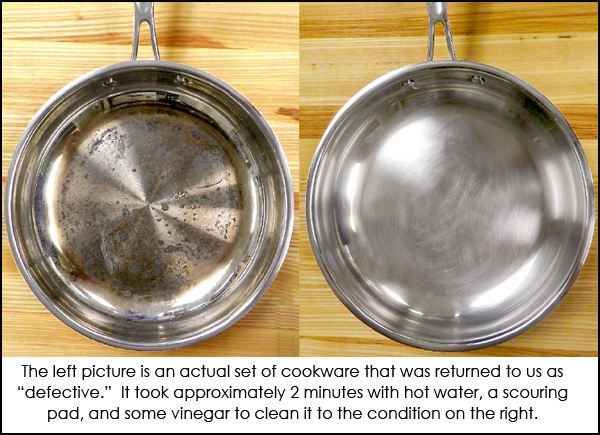Many of our resort customers prefer to use stainless steel cookware in their units. While it’s typically considered more “upscale” than non-stick cookware, it’s also likely to last longer because the non-stick cookware is prone to scratching if a guest misuses it (would a guest ever cook in nonstick cookware using a fork & knife at home?)
While the above is largely true, stainless steel can also incur damage. As with any cookware or flatware, the damage is mainly also through misuse (much to most housekeepers’ & GMs’ chagrin.) One common cause of damage to stainless cookware is the cookware being exposed to long duration of high heat with light and/or no load. This is typically evidenced by *the following:
- Discoloration on both the inside and outside SS surface. Over 800 degrees F
- Calrod brown ring marks on underside surface. Over 800 degrees F
- in extreme cases, melting of the aluminum layer which occurs at 1220 degrees F
*source: Cuisinart Engineering Dept
Additionally, heating any stainless steel to a temperature over 800 degrees can actually cause metallurgical changes that can reduce the natural corrosion resistance of stainless steel.
More frequently than the above, your housekeeping staff will run into cookware with burned/charred food solidified and caked to the inside of the cookware. This is frequently accompanied with slight discoloration to the steel. This is still indicative of misuse by the guest, however can typically be cleaned to near new condition (see example image.) Typically warm water, a nylon scrubber scouring pad, a powdered cleaner like Comet® and 2 minutes of “elbow grease” is enough to bring the cookware back to usable condition, and most of the time to near new condition. Lemon juice can also help cut through the charred food. We highly recommend nylon brushes or scouring pads over steel wool. That said, below are some more specific solutions to cleaning your cookware:

Vinegar for calcium spots: White streaks and “chalky” spots are usually the result of lime scale or calcium deposits. This happens frequently at properties with hard water (water with high mineral content.) While many sources recommend CLR for cleaning calcium, it’s not exactly “food-grade” and also is corrosive and gives off hazardous fumes. The best solution is vinegar. Simply soak the pan in vinegar and then clean as usual with mild detergent and a soft cloth or nylon brush. Vinegar also works on many of the hard to clean spots that are typically left behind after a regular cleaning. It can also be added to a dishwasher cycle if you’re cleaning your cookware in the dishwasher (while hand-washing is preferred, only stainless steel should be used in a dishwasher, never do this with non-stick cookware.)
Baking Soda on burned/charred food: You might try filling the cookware with water and 1-2 tsp of dishwashing detergent to a boil and after letting it soak for 20-30 minutes, removing as much of the charred food as possible with a nylon brush of something hard but nonabrasive like a wooden spoon. If there is still stubborn charred food clinging to the steel, then cover those areas with a generous amount of baking soda and drizzle in enough water to turn it into a thick paste, smearing the paste wherever needed, and then let sit for over 4 hours, preferably overnight. Afterward simply clean as usual with mild detergent and a soft cloth or nylon brush. If really stubborn, then leave cookware with the paste overnight and the next day bring it to a boil with a water/vinegar combination (3:1 ratio respectively.)
Specialty cleansers for hard stains: On occasion grease or food actually seems to cook itself into the steel (high heat) which causes slight discoloration to the cookware. In this case there are several cleansers specifically designed for use on stainless steel. Two common cleansers are Steel Glo and Barkeeper’s Friend. Simply make a paste with these cleansers by adding water and then rub it on the surface of the pan. Start in the center and work your way outward, all the while following the natural rings in the stainless steel.
Paste of water & baking soda to polish your stainless cookware: Simply creating this paste and rubbing it gently onto the steel cookware and then rinsing water is a great way to polish your cookware to a nice shine.
Steer clear of harsh chemicals: Bleach, ammonia and other harsh chemicals can discolor & damage your cookware. Stick to the solutions above & you should be good to go. Used properly and cared for properly, your stainless steel cookware should last several years, and in some cases decades. Hopefully your guests are aware of the above and use your cookware properly. However, if they don’t, certainly free free to browse our selection of stainless steel cookware, specifically designed with the resort industry in mind.

Recent Comments